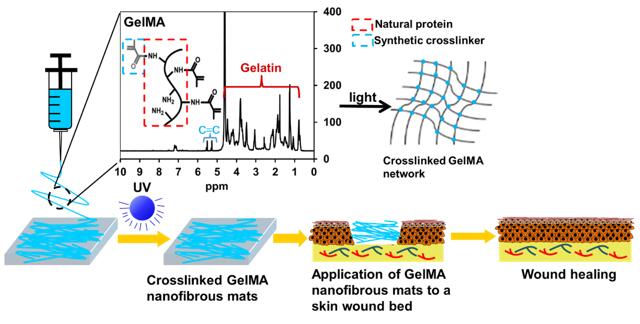Healing of skin wounds as caused by
acute trauma, burns and surgical procedures depends on an intricate interplay
between cellular factors and surrounding extracellular matrix (ECM). Tissue
engineering strategies seek to accelerate wound healing by providing the wound
bed with an artificial matrix like electrospun mats with ECM-like nanofibrous
architecture. However, the nanoporous structures of these scaffolds limit
three-dimensional (3D) cell infiltration into the scaffolds, while enlarged
pore size of the fibrous scaffolds for cell infiltration may compromise the
mechanical properties and dimensional stability of the scaffolds. To address
this, electrospun nanofibers with tuneable physical properties without changing
the pore dimensions have been studied for better cell infiltration. However, the
existing electrospun fibers are commonly made of synthetic polymers which
usually lack cell-recognition signals and render them less ideal for skin
regeneration applications. Therefore, development of natural polymer-based
fibrous scaffolds with tunable physical and biological properties is highly
desirable to construct a 3D, fully cellularized scaffold for wound healing.
Recently, Dr. Xin Zhao from Bioinspired
Engineering and Biomechanics Center at Xi'an Jiaotong University in collaboration
with Prof. Ali Khademhosseini from Harvard University have developed 3D
electrospun hydrogel fibrous scaffolds with soft elasticity made of
photo-crosslinkable gelatin (GelMA), which were found to be able to support
cell infiltration and accelerate wound healing. GelMA, modified from natural
polymer gelatin with methacrylates, has tunable physical and biological
properties. By changing the light exposure time, i.e., the crosslinking density
of the GelMA hydrogel fibers, the GelMA hydrogel fibrous scaffolds can be
varied to be soft and elastic, supporting cell adhesion, proliferation and
migration into the whole scaffolds and accelerating skin regeneration. Such
tunable properties have enabled the GelMA hydrogel fibrous scaffolds to
accommodate different patients’ needs, which is in stark contrast with the
conventionally used electrospun gelatin or poly
(lactic-co-glycolic acid) scaffolds whose physical properties
cannot be readily tuned. It is envisioned that the GelMA hydrogel fibrous
scaffolds have great clinical potential for skin regeneration. Details of this
work can be obtained from Acta
Biomaterialia (DOI: http://dx.doi.org/10.1016/j.actbio.2016.11.017).
